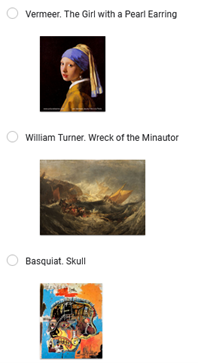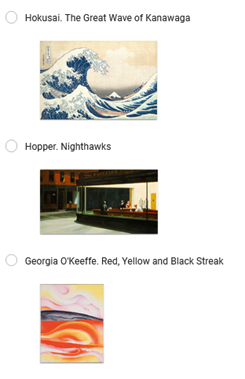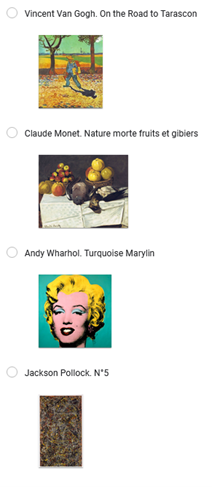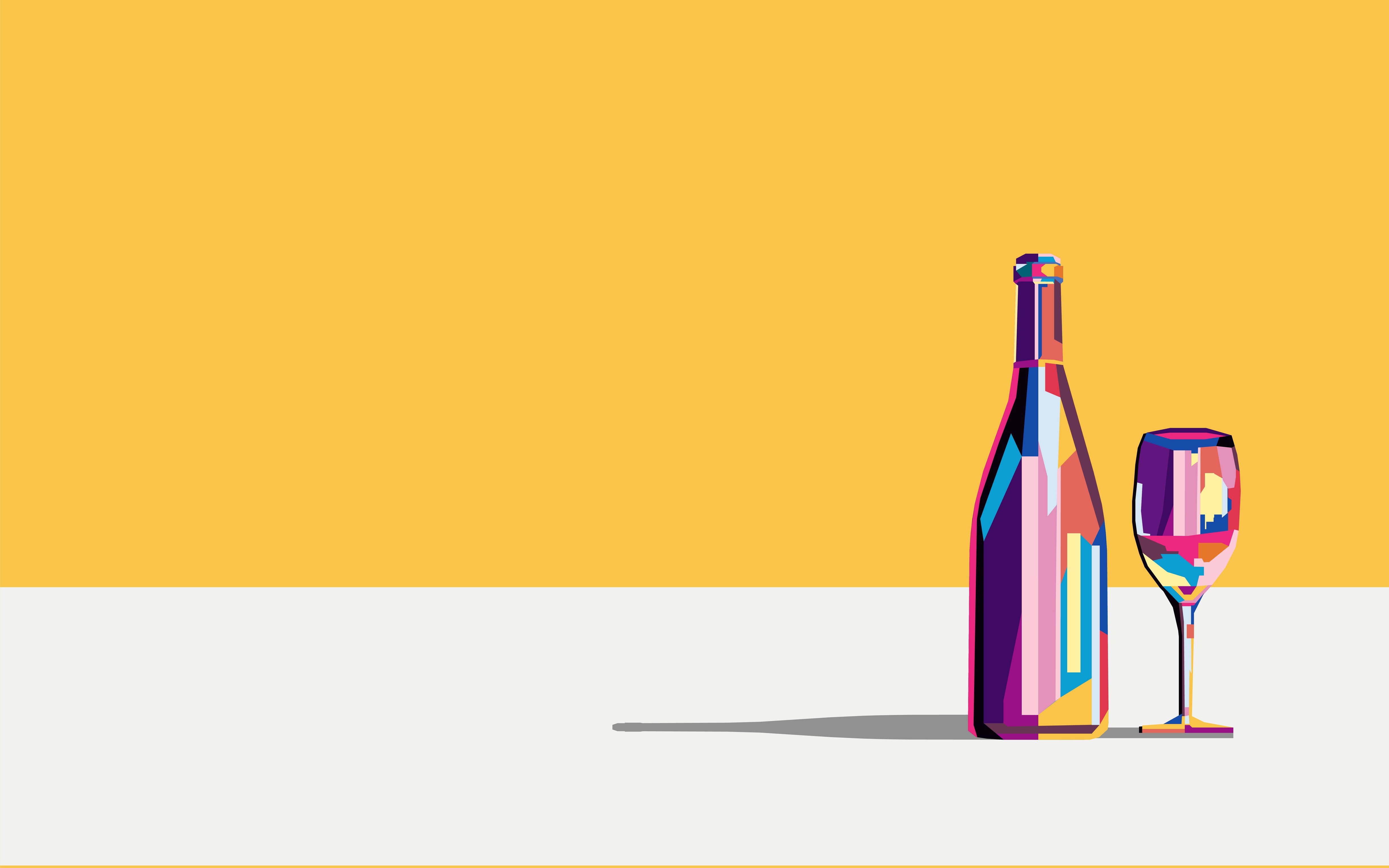For a few years now, Gildas L'Hostis, EHL Senior Lecturer in Oenology (the knowledge of wine, wine service, production, economics and tasting), has been trying out new tools enabling students to express themselves more freely and creatively. The synesthetic approach is a method that shuns traditional analytical wine tasting along with the ubiquitous wine tasting ‘grid’, replacing it with a more imaginative practice that summons up many of the senses. Here, students are encouraged to practice wine pairing by creating matches with specific paintings.
Creating synesthetic matches between art and wine
About five years ago, I began asking my preparatory year students in the wine tasting sessions to “pair” wine with a painting. This “pseudo-synesthetic” approach enables students to express themselves more freely. Synesthesia is a specific, though largely harmless, neurological condition. People who actually have this condition associate different senses in an involuntary, arbitrary and instantaneous way. For example, they will pair graphemes with colors; music with a specific color, or sound with a particular taste.
The exercise we do in class is, therefore, pseudo-synesthesia, insofar as I ask students to create synesthetic matches but in a voluntary and more rational way than pure synesthesia. When we eat, smell, or hear something we are activating more than one sense – in fact, we’re using all our senses in an interconnected way to produce the whole image of a food product, sound or picture. It seems perfectly legitimate to try to identify intermodal relationships between wine and painting in a way that is unlike the traditional tasting card when trying to better understand wine.
This article is the result of this experience, now in its fifth year, with students in the preparatory year using data collected in 2020.
Intuitive vs. wine tasting
Analytic tasting is the most popular wine tasting method. It consists in following set criteria in a mechanical and almost mathematical way - i.e., a tasting grid - and is practically the only one used by professionals and amateurs when learning about or assessing wine. It enables its users to evaluate a wine in a qualitative and sometimes quantitative way, by assigning a rating to the wine. The first objective of this method seems to be to strip out all subjectivity or ambiguity related to this approach, which is hedonistic by definition.
The advantage of this method is that it enables tasters to put their opinions into words using a shared vocabulary, which is sometimes restricted to a defined set of words to avoid interpretations that would be too personal: one person might understand their description while the others would fail to comprehend it. Using a shared lexicon, the consumer avoids any misunderstanding. Indeed, imprecise or incomprehensible language could make wine evaluation problematic.
However, analytic tastings tend to limit the consumer as they leave little room for intuition or creativity. Hedonistic products cannot be judged solely based on objective attributes; instead, they need to be evaluated more holistically.
There are other, more intuitive alternatives with greater semantic legroom that provide more latitude for personal expression. For instance, Franck Thomas - via his training firm (Franck Thomas Formation) - has developed what he calls "an institutive tasting approach", which is based on the taster’s perceptions. This method is combined with an analytical tasting, thus proving that the two can exist side-by-side.
Organization of the tasting class
Introduction to the main synesthetic concepts
A brief introduction is conducted to prevent the tasting from just being about fun or eliciting an overly emotional or flippant response from students. First, the students are informed that the wines being presented are complex for all senses and that they must go above and beyond simply saying whether they ‘like’ the wine or not. Students are warned to look closely at the paintings and observe the colors, light, shapes, lines, curves, etc.
In addition, I explain in relatively simple terms the interactions that occur in the brain between the different senses and the fact that one sense in particular doesn’t usually come with its own vocabulary list. People, for instance, tend to use the same words when describing wine, music or paintings. In order to highlight the interconnection of the senses and to facilitate students’ understanding of this exercise, I use the concept of Kiki and Bouba (J. Bremner and al. 2012). The shapes can be matched with a sound and also a flavor.

1st question: Who is Kiki and who is Bouba? Students tend to answer almost instantaneously. Bouba is on the left of the image
2nd question: Of the two shapes, Kiki and Bouba, which is the most acidic?Students’ responses are also nearly instantaneous, Kiki (on the right) is the most ‘acidic’ shape.
The tasting : pairing wine with paintings
From the outset of the study, we’ve always tasted the same wine and vintage: Ambre 2007, Valais, Christophe Abbet. It is not a blind tasting (only the name of the wine and the vintage are communicated to students). For the tasting, the wine has an amber color, the nose is very expressive with tremendous aromatic complexity: honey, quince, whisky, orange zest, spices, etc. The mouthfeel is ample and generous and the wine might first appear to be very sweet but the acidity gives it an exceptional energy. It is a perfect combination of roundness and acidity.
Students have 10 minutes to describe the wine on a blank piece of paper.
They then receive a form (anonymous) that they must complete including various information: team, gender, nationality, most frequently-spoken language, description of the wine.
The choice of questions associated with gender and nationality help establish a link (or lack thereof) between the students’ answers and the choice of painting.
11 paintings were then suggested. This choice was primarily established based on the wine’s aroma and flavors as well as its visual aspect. The idea was that some paintings can be easily associated with wine while for others it is more difficult because of the shapes, colors that are projected by the painting. Students can only choose one painting from among the choices and they must justify their decision.
Even though it seems that certain pairings are more obvious than others, it is important to explain to the students that what is most important is their justification and not the choice itself.



The students have around 15 minutes to fill out the form, choose their painting and justify their choice.
The last part is dedicated to a classroom discussion where each student is asked to speak and read more or less what they’ve written in the form. This discussion is crucial because it often opens up the floor to other interpretations that tend to be very enriching.
Although the quality of comments varies (depending on the team or student), generally speaking the exchanges were prolific and many students who were rather shy during the analytical tasting are much less timid during these sessions. Students tend to use their emotions to express themselves but they also use a healthy dose of rationality when comparing wine and painting. Some comments, however, are a touch too emotional and it is sometimes hard to ascertain where the student is going with their comment. In such cases, the student is asked to clarify their comments so the entire class can understand better.
Choice of paintings - the findings
While the results are not meant to stand up to scientific scrutiny (the study’s methods would need to be more robust and deploy other statistical tools that go beyond reading graphs), they reveal several trends.
The most interesting finding is undoubtedly the fact that they emphasize two paintings. In fact, two clusters stand out quite clearly. The paintings of Vincent Van Gogh (24%) and Georgia O’Keeffe (34%) are among the most frequently chosen. In my opinion, these two paintings had the most in common with wine (tones, light, shapes, etc.). Of course, student comments are very personal (emotion remains an important factor in forming an opinion) but they often highlight semantic and intersensory links that are very clear between paintings and wine, including the complexity of paintings, warmth, acidity (linked to light), sweetness, etc.

The students' comments
Van Gogh. On The Road to Tarascon
“Due to the strong honey taste and sweet notes, I felt a warmness inside that reminded me of fall. You can see the leaves on the floor with a warm coloring similar to the feeling I get when drinking the wine. Furthermore, the shadow of the man in the picture represents the deepness and complexity. Van Gogh's paintings in general seem simple at the first look but him using a special technique with dots everywhere to create something that melts together fits perfectly with the different notes of sweetness and sourness as well as the fact that at first the sweetness is very pungent but later on it just stays subtle in the mouth and there is more to it. “
“I chose this painting because for me it represents perfect balance between the color sweetness acidity and the emotions felt while drinking the wine. This wine gives me a feeling of peace just like the painting the wine expresses its emotions: peaceful, sweet like a hug from a loved one. The painting gives the same peaceful and happy and homelike emotions. personally, this wine touches emotions like no other and I think that this wine with the painting represents the warmness and the love. It reminds me of the love of a father. This wine is art”
Georgia O’Keeffe. Red, Yellow and Black Streak
“The painting resonates a sense of calm even with the brightest colors, the wine is very sweet yet is balanced in a way that makes the whole tasting experience harmonic and melodic. It takes you to an alternate universe with the sweetness and syrupy consistency. The swirls and the wine tasting experience in terms of length are very smooth and silky, from the smell to the initial tasting and the swallowing, it's all very balanced and monotonous which is subsequently evident in the painting by Georgia O’Keeffe”
“The different colors on the painting are similar to the feelings that you get after drinking the wine. The color yellow represents the sweet mellow smell and taste of jaggery, the light pink depicts the personality and the black streak showcases the contrast of little bit of acidity which makes the wine well balanced. The different layers of the painting are the perfect presentation of the different flavors and complexity of taste at different levels. There are no rigid lines on the painting, everything flows into each other very calmly just like the sensation you get after drinking the wine.”
Gender
The graphs don’t reveal any disparities between genders with regard to the choice of painting. The lone conclusion that we can apparently draw is that gender does not influence (or at least not very much) students’ choice. The results, undoubtedly, would have to be analyzed at a much deeper level.
Nationality
Once again, the graphs don’t reveal that there are any clear trends about whether nationality does or does not influence the choice of painting.
A unique wine tasting experience
Utilizing this kind of ‘pseudo synesthesia’ method in a multi-sensory exercise makes wine tasting more intuitive, freeing students up to be more creative because they do not have to focus exclusively on one sense. It provides students with an alternative way of forming a comprehensive opinion of wine.
To see if most students had enjoyed this unique wine-tasting experience, I asked them, over the course of the semester, to provide their anonymous opinion of the exercise. Of the 147 responses, more than 92% of students found it to be both useful and interesting.
While this exercise makes for an original wine-tasting experience that is less constraining from a linguistic point of view (because it doesn’t circumscribe a wine tasting to a limited series of words), it is, however, not easy to pull off. This approach is, of course, more creative but it compels students to make a substantial intellectual effort as they search for similarities between wine and painting. In addition, the capacity of the student to draw connections between wine and art also largely depends on the depth of their linguistic aptitude.





